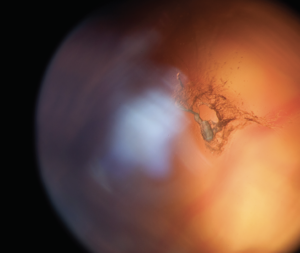Laser Floater Removal (Vitreolysis) at Boston Eye Group
 Vitreous floaters occur when the clear vitreous gel that occupies the venter of the eye changes consistency which is most often due to the normal aging process. When this happens, clumps of protein in the eye move around like snow in a snow globe and cast a shadow which we perceive as a “floater.” It is estimated that 75% of the population will develop symptomatic of floaters at some point during our lifetime. Symptoms of floaters include the perception of a bug, hair, clouds, or cobwebs that float within our field of view. Floaters occur more commonly in individuals that are near-sighted, over the age of 40, and after eye surgery such as cataract surgery or YAG laser capsulotomy. Most cases of floaters represent a harmless change to the vitreous gel and require no treatment. On rare occasions, the development of floaters can be associated with the development of a retina tear or detachment which requires surgical intervention. This is why new onset floaters should be evaluated by your doctor as soon as possible.
Vitreous floaters occur when the clear vitreous gel that occupies the venter of the eye changes consistency which is most often due to the normal aging process. When this happens, clumps of protein in the eye move around like snow in a snow globe and cast a shadow which we perceive as a “floater.” It is estimated that 75% of the population will develop symptomatic of floaters at some point during our lifetime. Symptoms of floaters include the perception of a bug, hair, clouds, or cobwebs that float within our field of view. Floaters occur more commonly in individuals that are near-sighted, over the age of 40, and after eye surgery such as cataract surgery or YAG laser capsulotomy. Most cases of floaters represent a harmless change to the vitreous gel and require no treatment. On rare occasions, the development of floaters can be associated with the development of a retina tear or detachment which requires surgical intervention. This is why new onset floaters should be evaluated by your doctor as soon as possible.
Historically doctors have told patients to tolerate and learn to live with floaters because A) they do not harm the eye and B) the surgical interventions typically had risks which outweighed the benefits. A vitrectomy is a surgery performed by a retina specialists where all of the vitreous gel is removed from the eye. This procedure, although becoming more safe with advancing technology, carries risks of complications such as infection, macular edema and retinal detachment. Most surgeons reserve vitrectomy for the most severe and distressing cases only.
Laser vitreolysis, also referred to as “Laser Floater Removal” (LFR), involves the use of a nano-pulsed ophthalmic YAG laser to vaporize vitreous strands and opacities. This procedure does not carry the same level of risks of infection, bleeding or retinal detachment that comes with vitrectomy. And with recent advancements in YAG laser technology, including Reflex Technology™ from Ellex, ophthalmologists can offer their symptomatic floater patients treatment with laser vitreolysis with greater safety and efficacy than ever before.
About Laser Floater Removal (LFR)
YAG laser technology has been used in ophthalmology for decades. But recent advances in the laser allows surgeons to have a better view of your floaters and provides a tighter, safer energy pulse. This has allowed doctors to feel more comfortable using this laser safely in the back of the eye. The YAG energy converts the collagen and hyaluronic molecules found in a floater into a gas, which is then resorbed into the eye.
To consider Laser Floater Removal, our surgeons recommend that your floaters be observed for 3-6 months before proceeding because many floaters resolve on their own. We also require a full dilated eye exam and evaluation of your retina to rule out other problems prior to proceeding with treatment. LFR is easier to perform after you have already had cataract surgery but still having your natural lens does not rule you out as a candidate.
Results
In 2018, Boston Eye Group was the first practice in New England to purchase the new Ellex laser technology and to perform LFR outside of a research setting. Our experience is extensive and mirrors published studies that find, on average, most patients can expect a 60% to 90% improvement in the size, severity and frequency of floaters. On average people require 1.5 laser treatment sessions which depends on the size of your initial floater. As of February 2020, Boston Eye Group has had zero cases of retinal tears or detachments after Laser Floater Removal treatment.
